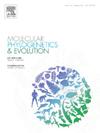Whole genome sequencing and phylogenetic analyses of the Sillaginidae family fish
IF 3.6
1区 生物学
Q2 BIOCHEMISTRY & MOLECULAR BIOLOGY
引用次数: 0
Abstract
For a long time, the taxonomic study of the Sillaginidae family of fish has been relatively slow, leaving the evolutionary relationships among species unclear. Previous research has mainly relied on morphological characteristics, with molecular studies limited primarily to mitochondrial genomics, including analyses of gene fragments and whole mitochondrial genomic sequence. This approach resulted in less precise and comprehensive species identification. In this study, we employed high-depth whole-genome sequencing (WGS) and genome surveys on 13 specimens representing 9 species of Sillaginidae fish collected from the wild. Our analysis included a thorough genomic survey and the assembly of draft genomes for each specimen. The genome sizes of Sillaginidae species are highly similar, ranging from 511.71 Mb to 578.27 Mb, with most individuals exhibiting repeat sequences content below 34.69 %. After the genome draft assembly of each sample, we identified conserved genes and shared consistent sequences among individuals and constructed a species phylogenetic tree based on these data. The results revealed that Sillago ingenua occupies the basal branch, followed by S. maculata and S. aeolus, then Sillaginopsis panijus, S. japonica and S. asiatica, and finally S. nigrofasciata and S. cf. sihama. Subsequently, we validated the phylogenetic tree using genome-wide single nucleotide variations, and the results were highly consistent. This research provides, for the first time, a whole-genome perspective on the evolutionary relationships among Sillaginidae species, offering valuable insights into their taxonomy and historical evolution.

Sillaginidae科鱼类全基因组测序及系统发育分析。
长期以来,对石首鱼科(Sillaginidae)鱼类的分类研究相对缓慢,导致物种间的进化关系不明确。以往的研究主要依赖形态特征,分子研究主要局限于线粒体基因组学,包括基因片段和整个线粒体基因组序列的分析。这种方法导致物种鉴定不够精确和全面。在这项研究中,我们采用了高深度全基因组测序(WGS)和基因组调查的方法,对从野外采集到的代表 9 个品种的 13 个 Sillaginidae 鱼类标本进行了分析。我们的分析包括对每个标本进行全面的基因组调查和组装基因组草案。石首鱼科物种的基因组大小高度相似,从511.71 Mb到578.27 Mb不等,大多数个体的重复序列含量低于34.69%。在对每个样本进行基因组草图组装后,我们确定了个体间的保守基因和共享一致序列,并根据这些数据构建了物种系统发生树。结果显示,Sillago ingenua 属于基部分支,其次是 S. maculata 和 S. aeolus,然后是 Sillaginopsis panijus、S. japonica 和 S. asiatica,最后是 S. nigrofasciata 和 S. cf. sihama。随后,我们利用全基因组单核苷酸变异对系统发生树进行了验证,结果高度一致。这项研究首次从全基因组的角度探讨了Sillaginidae物种之间的进化关系,为其分类学和历史演化提供了宝贵的见解。
本文章由计算机程序翻译,如有差异,请以英文原文为准。
求助全文
约1分钟内获得全文
求助全文
来源期刊
CiteScore
7.50
自引率
7.30%
发文量
249
审稿时长
7.5 months
期刊介绍:
Molecular Phylogenetics and Evolution is dedicated to bringing Darwin''s dream within grasp - to "have fairly true genealogical trees of each great kingdom of Nature." The journal provides a forum for molecular studies that advance our understanding of phylogeny and evolution, further the development of phylogenetically more accurate taxonomic classifications, and ultimately bring a unified classification for all the ramifying lines of life. Phylogeographic studies will be considered for publication if they offer EXCEPTIONAL theoretical or empirical advances.

 求助内容:
求助内容: 应助结果提醒方式:
应助结果提醒方式:


